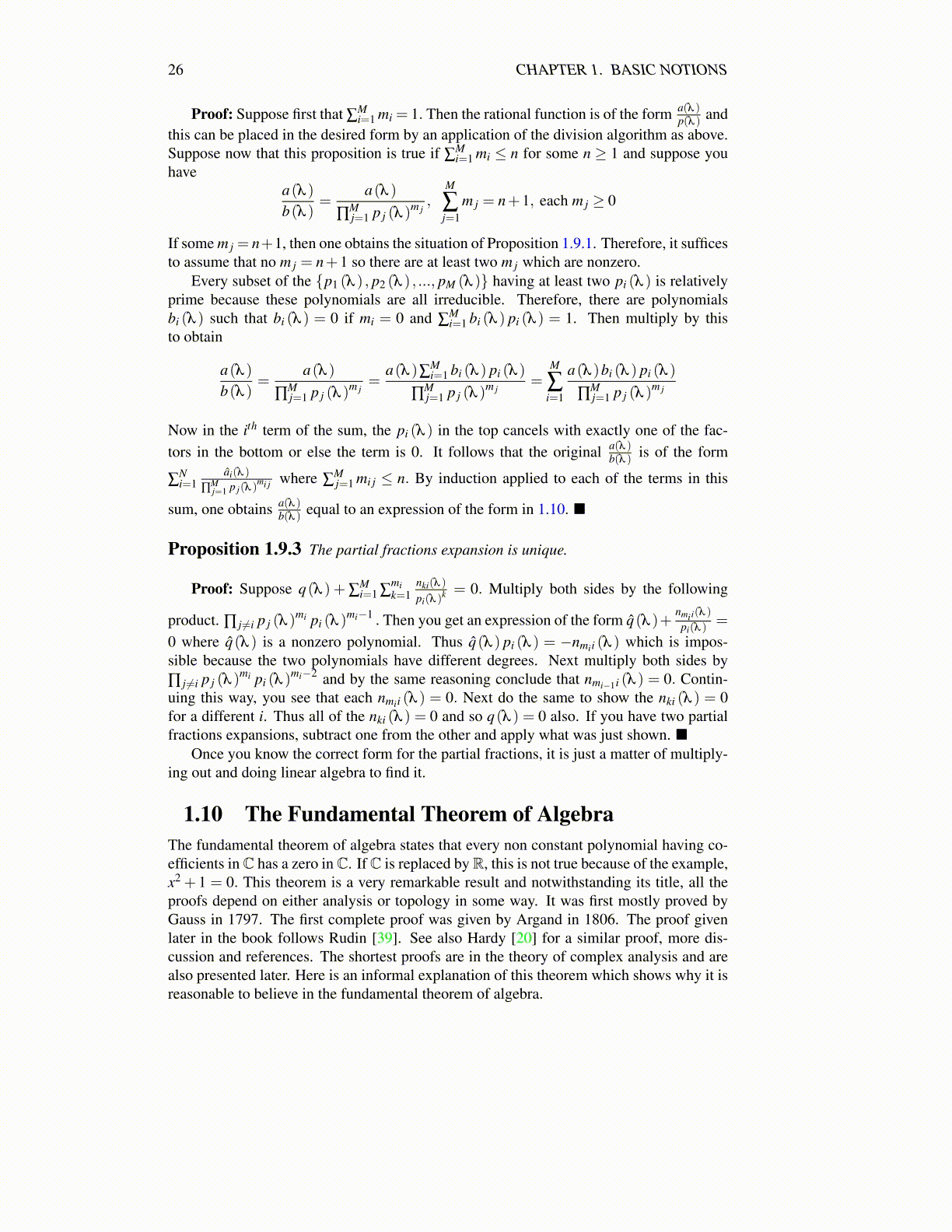
26 CHAPTER 1. BASIC NOTIONS
Proof: Suppose first that ∑Mi=1 mi = 1. Then the rational function is of the form a(λ )
p(λ ) andthis can be placed in the desired form by an application of the division algorithm as above.Suppose now that this proposition is true if ∑
Mi=1 mi ≤ n for some n ≥ 1 and suppose you
havea(λ )b(λ )
=a(λ )
∏Mj=1 p j (λ )
m j,
M
∑j=1
m j = n+1, each m j ≥ 0
If some m j = n+1, then one obtains the situation of Proposition 1.9.1. Therefore, it sufficesto assume that no m j = n+1 so there are at least two m j which are nonzero.
Every subset of the {p1 (λ ) , p2 (λ ) , ..., pM (λ )} having at least two pi (λ ) is relativelyprime because these polynomials are all irreducible. Therefore, there are polynomialsbi (λ ) such that bi (λ ) = 0 if mi = 0 and ∑
Mi=1 bi (λ ) pi (λ ) = 1. Then multiply by this
to obtain
a(λ )b(λ )
=a(λ )
∏Mj=1 p j (λ )
m j=
a(λ )∑Mi=1 bi (λ ) pi (λ )
∏Mj=1 p j (λ )
m j=
M
∑i=1
a(λ )bi (λ ) pi (λ )
∏Mj=1 p j (λ )
m j
Now in the ith term of the sum, the pi (λ ) in the top cancels with exactly one of the fac-tors in the bottom or else the term is 0. It follows that the original a(λ )
b(λ ) is of the form
∑Ni=1
âi(λ )
∏Mj=1 p j(λ )
mi j where ∑Mj=1 mi j ≤ n. By induction applied to each of the terms in this
sum, one obtains a(λ )b(λ ) equal to an expression of the form in 1.10. ■
Proposition 1.9.3 The partial fractions expansion is unique.
Proof: Suppose q(λ ) + ∑Mi=1 ∑
mik=1
nki(λ )
pi(λ )k = 0. Multiply both sides by the following
product. ∏ j ̸=i p j (λ )mi pi (λ )
mi−1 . Then you get an expression of the form q̂(λ )+nmii(λ )
pi(λ )=
0 where q̂(λ ) is a nonzero polynomial. Thus q̂(λ ) pi (λ ) = −nmii (λ ) which is impos-sible because the two polynomials have different degrees. Next multiply both sides by∏ j ̸=i p j (λ )
mi pi (λ )mi−2 and by the same reasoning conclude that nmi−1i (λ ) = 0. Contin-
uing this way, you see that each nmii (λ ) = 0. Next do the same to show the nki (λ ) = 0for a different i. Thus all of the nki (λ ) = 0 and so q(λ ) = 0 also. If you have two partialfractions expansions, subtract one from the other and apply what was just shown. ■
Once you know the correct form for the partial fractions, it is just a matter of multiply-ing out and doing linear algebra to find it.
1.10 The Fundamental Theorem of AlgebraThe fundamental theorem of algebra states that every non constant polynomial having co-efficients inC has a zero inC. IfC is replaced byR, this is not true because of the example,x2 + 1 = 0. This theorem is a very remarkable result and notwithstanding its title, all theproofs depend on either analysis or topology in some way. It was first mostly proved byGauss in 1797. The first complete proof was given by Argand in 1806. The proof givenlater in the book follows Rudin [39]. See also Hardy [20] for a similar proof, more dis-cussion and references. The shortest proofs are in the theory of complex analysis and arealso presented later. Here is an informal explanation of this theorem which shows why it isreasonable to believe in the fundamental theorem of algebra.